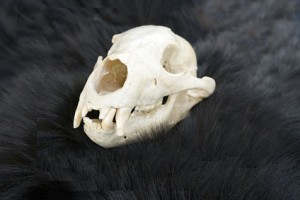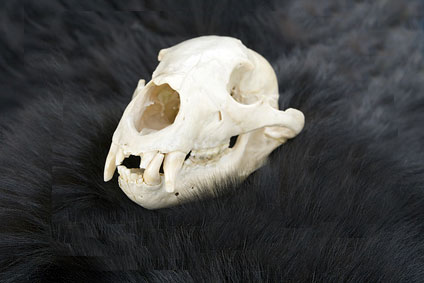After you’ve created a beautiful European skull mount, you want to keep it clean and flawless-looking. Fortunately, if the mount was cleaned properly, bleached, and given a protective coating when it was made, this will be extremely easy.
Mounts that were given a protective polyurethane or acrylic spray coat are a breeze to keep clean. A simple dusting now and then should suffice, though care should be taken to be gentle, so no teeth or horns are knocked loose, and no bones get chipped. Feather dusters and other gentle, minimal-contact dusters are the best for keeping skull mounts dust free, without having to worry about any further damage. If the mount was not given a protective coat, it should be cleaned thoroughly and given one.
 If a skull mount ever gets to the point where it requires further cleaning, a damp rag is the best way to do it. Protective coatings can prevent staining, and any cleaning after the coating is applied needs to ensure that it isn’t accidentally stripped off. Rubbing alcohol, acetone, solvents, or some detergents can cause yellowing, clouding, chipping, softening, or even stripping of the protective layer, so they shouldn’t ever be used. A soft, lint-free cloth barely dampened with some clean water is all that should be used, and care should be taken that the skull is allowed to dry out completely afterwards, to avoid mold, mildew, or insects.
If a skull mount ever gets to the point where it requires further cleaning, a damp rag is the best way to do it. Protective coatings can prevent staining, and any cleaning after the coating is applied needs to ensure that it isn’t accidentally stripped off. Rubbing alcohol, acetone, solvents, or some detergents can cause yellowing, clouding, chipping, softening, or even stripping of the protective layer, so they shouldn’t ever be used. A soft, lint-free cloth barely dampened with some clean water is all that should be used, and care should be taken that the skull is allowed to dry out completely afterwards, to avoid mold, mildew, or insects.
Small spaces between teeth and in small skull cavities can be cleaned using artist’s brushes, pipe cleaners, and the canned air dispensers used for keyboards. These areas shouldn’t be allowed to get wet, so a skull shouldn’t ever be immersed, but these tools can all be used to get into tiny spaces and crevices without using any water. Artist’s brushes come in a wide variety of shapes, sizes, and materials suitable for different parts of a skull, however pipe cleaners have the advantage of being able to be bent into different configurations for cleaning inside long cavities and around corners. However, care should be taken that the hard, wire core of the pipe cleaners isn’t allowed to scratch the skull’s coating, or chip small pieces of bone off.
If any teeth are loose, these can be repaired after dusting with a little bit of carefully applied super glue. Fit the tooth in its socket, remove it, add a small amount of glue, replace the tooth, and let it dry completely. Make sure the brand of glue dries clear, and is guaranteed not to yellow over time. That way, if any glue accidentally makes its way somewhere visible, it won’t be noticeable and detract from the appearance of the skull mount.
European skull mounts are one of the easiest trophies to create and maintain, making them a popular choice for beginners. However, just because they’re easy to take care of doesn’t make them maintenance-free, but with a little common sense care, even an antique skull mount can look just as good as the day it was prepared.

